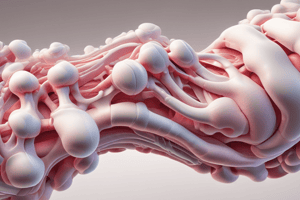Podcast
Questions and Answers
What characteristic is typical of a bone island (enostosis)?
What characteristic is typical of a bone island (enostosis)?
- Demonstrates predominantly trabecular structure
- Has a feathered border and long axis parallel to bone (correct)
- Appears as a centrally located lucency
- Shows extensive periosteal elevation
Which solitary sclerotic bone lesion is typically associated with significant calcification in large long bones compared to those in smaller bones?
Which solitary sclerotic bone lesion is typically associated with significant calcification in large long bones compared to those in smaller bones?
- Paget's disease
- Enchondroma (correct)
- Bone infarct
- Osteoma
In adults, which type of solitary sclerotic bone lesion is most likely to be caused by metastatic disease?
In adults, which type of solitary sclerotic bone lesion is most likely to be caused by metastatic disease?
- Osteoid osteoma
- Callus
- Lymphoma (correct)
- Bone island
What radiographic feature distinguishes a bone infarct from other lesions?
What radiographic feature distinguishes a bone infarct from other lesions?
Which lesion is characterized by sclerosis caused by eccentric periosteal thickening?
Which lesion is characterized by sclerosis caused by eccentric periosteal thickening?
Which solitary sclerotic bone lesion is commonly associated with Gardner syndrome when multiple lesions are present?
Which solitary sclerotic bone lesion is commonly associated with Gardner syndrome when multiple lesions are present?
Flashcards
Bone Island
Bone Island
A small, ovoid bone growth, parallel to the bone's axis, with a feathered edge.
Enchondroma
Enchondroma
A cartilage tumor with speckled, or confluent, calcifications, denser in the middle than at the edges.
Metastasis
Metastasis
Cancer spread to the bone from another part of the body.
Bone Infarct
Bone Infarct
Signup and view all the flashcards
Osteoma
Osteoma
Signup and view all the flashcards
Osteoid Osteoma/Osteoblastoma
Osteoid Osteoma/Osteoblastoma
Signup and view all the flashcards
Study Notes
Solitary Sclerotic Bone Lesions: Common Types
- Bone Island (Enostosis): Oval shape, long axis aligned with bone's axis, and a "feathered" edge.
- Enchondroma: Consists of clustered, small, or rounded calcifications, appearing denser in the center than the edges. Enchondromas in larger bones are more often calcified than those in fingers.
- Metastasis: Cancers like prostate, breast, gastrointestinal (GI) tract (mucinous adenocarcinoma), carcinoid, lymphoma, and transitional cell carcinoma (TCC) in adults, and medulloblastoma and neuroblastoma in children.
- Callus: Usually seen with a spindle-shaped swelling in long bones.
Solitary Sclerotic Bone Lesions: Less Common Types
- Paget's Disease: The sclerosis is part of a broader process of bone expansion, with cortical and trabecular thickening.
- Osteoma: Originates from membranous bone (skull and paranasal sinuses). Defining feature is a lack of internal trabeculae ("ivory osteomas"). Mature osteomas display visible marrow. Multiple osteomas raise suspicion of Gardner syndrome.
- Osteoid Osteoma/Osteoblastoma: Sclerosis due to eccentric thickening of the periosteum. Osteoid osteomas display a radiolucent nidus (center).
- Bone Infarct: Typically shows a central radiolucent area in the metadiaphysis (middle shaft) region of long bones, with thin, winding, calcified margins.
Studying That Suits You
Use AI to generate personalized quizzes and flashcards to suit your learning preferences.



